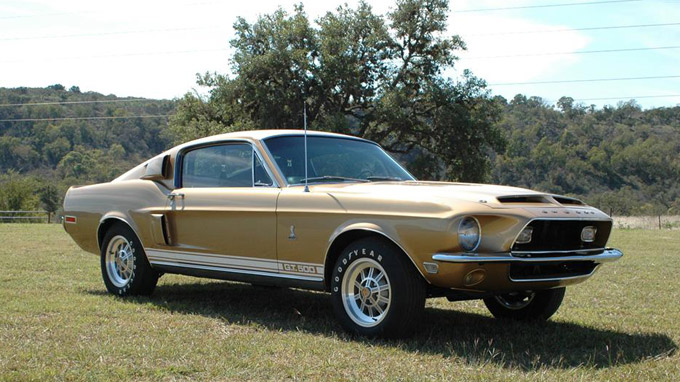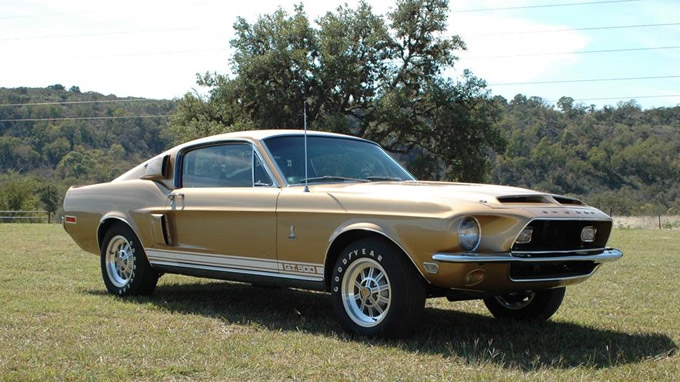
- 428-ci Police Interceptor V8 engine
- Balanced and blueprinted by Duffin’s Machine Shop
- Automatic transmission
- Built at Ford’s Metuchen plant on December 21, 1967
- Restored to original by Randal’s Restorations
- The steel wheels and hubcaps have been upgraded to 10-spoke wheels
- Aside from the mag wheel upgrade, this Shelby is like it was the day it came off the assembly line
{auto}1603{/auto}
SCM Analysis
Detailing
| Vehicle: | 1968 Shelby GT500 fastback |
| Years Produced: | 1968 |
| Number Produced: | 1,140 (GT500) |
| Original List Price: | $4,317 |
| SCM Valuation: | $90,000–$127,500 |
| Tune Up Cost: | $200 |
| Distributor Caps: | N |
| Chassis Number Location: | Driver’s side door tag |
| Engine Number Location: | Pad on the back of the block on the driver’s side |
| Club Info: | www.saac.com |
| Website: | www.mustangforums.com |
| Alternatives: | 1968 Ford Mustang GT 428CJ fastback, 1968 Chevrolet Yenko Camaro 427 coupe, 1968 Mercury GT-E 427 2-dr hard top |
| Investment Grade: | N |
This car, Lot 469, sold for $93,500, including buyer’s premium, at the Leake Auction Co. sale in San Antonio, TX, on April 20–21, 2012.
By 1968, Ford had all but taken over production of the Shelby Mustang. Sales were dramatically up, with over six times more cars sold in 1967 than 1966. The 1968 model was expected to sell even more, which required a more fluid production process than had been acceptable in the past.
The Shelby-designed fiberglass parts were now supplied by A.O. Smith in Ionia, MI (the same company supplying GM with Corvette bodies). As such, Shelby Automotive set up shop in Livonia, MI, which was much closer to the assembly line building the cars. All 1968 Shelby Mustangs would be manufactured in Metuchen, NJ, and then shipped to the A.O. Smith facilities in Ionia for the final assembly, where they were given Shelby body accents and parts.
More creature comforts
In ’67, the hot new GT500 outsold the GT350 by nearly two to one (2,048 vs. 1,175). The early ’68 GT500s came equipped with the same Police Interceptor 428, only now it was equipped with a single 4-barrel rather than the previous year’s dual 4-barrel configuration. But the swap managed to up the horsepower rating to 360.
In April of 1968, Ford introduced the hot new 428 Cobra Jet (CJ) engine, which quickly found its way into the 1968 Shelby GT500 line — branding the new updated model as the GT500 KR. The published horsepower suspiciously dropped to 335, but rumors around the Saturday night cruise-in crowd pegged the real number at well over 400 hp.
A gold automatic — but still a Shelby
Our subject car was a standard GT500 built on December 21, 1967, and finished in Sunlit Gold. It was then shipped to Hemphill McCombs Ford Inc. of San Antonio, TX, on January 26, 1968. The car may have spent its entire life in Texas, although that’s only an assumption. But if that’s indeed the case, the body was probably rust-free.
David Randal, a well-known Texas-based Shelby restoration shop, had previously restored our subject car — Shelby chassis number 00880. The body was taken down to bare metal and finished with a base-coat clear coat by another Texas shop as directed by Randal’s team. The 428 Police Interceptor engine was balanced and blueprinted, and the restoration appears to have been well planned, thorough and detailed — but not overly so.
KRs, colors and the extra pedal premium
Shelbys like this trade relatively often, so there are plenty of comparable sales to help peg the current market. But our focus needs to stay squarely on the earlier built cars — those with the 428 Police Interceptor. Later GT500 KRs with the CJ engine will generally command about a 20% to 25% premium.
Valuing a well-sorted GT500 depends on variables such as quality, originality, documentation, color, options and transmission selection, to name a few.
This car’s color, although correct for the build, is a love-it-or-hate-it proposition. I think it’s attractive, but given the prospect of parting with some of my hard-earned cash as an investment (meaning I’d like to be able to easily sell it down the road), I’d prefer one in red or blue — and like most muscle buyers, I’d really rather have a 4-speed.
Our first comparable database entry is Lot S169, a 1968 Shelby GT500 that sold at the Mecum Kissimmee sale in January 2012 for $116,600 (ACC# 201280). This car was finished in Acapulco Blue, appeared to be well sorted with more documentation than our subject car, and included the game-changing 4-speed transmission. That car appeared to be in good condition but was certainly not over-the-top.
Next, another Mecum sale, this time in Dallas in October 2011. There, a 1968 GT500, Lot S150.1, found a new garage for $92,750 (ACC# 191111). This car was also finished in the desirable Acapulco Blue but also came with an automatic transmission, so in that regard, it’s more closely related to our subject car from a value perspective. But this example was in lesser condition than our subject.
Finally, an eBay sale noted in our database as Lot 330578483832 reported as sold for $75,101 on July 7, 2011 (ACC# 182265). This GT500 was finished in Lime Gold and was fitted with the 4-speed manual transmission and suggested to be in #2 condition. That car had previously gone unsold at RM’s Toronto, Canada, sale in October 2005, with a high bid of $92,000 (ACC# 39824).
The $100k barrier
So in this market, very nice, well-sorted 1968 GT500s have routinely traded for less than $100,000, with 4-speed cars generally finding more money — which is the norm for most muscle cars. But it’s important to note that all of the sales referenced here took place before Shelby’s death in May. I wouldn’t be surprised to see a boost in the values of his cars, although I think we’ll see that first with 289 and 427 Cobras and the earlier, more race-oriented 1965 and 1966 GT350s.
Typically, you can add anywhere from 10% to 25% for a third pedal, depending on the make and model, and the balance of the presentation and documentation. Keep in mind that none of our comparables, or our subject car, appear to be world-class concours examples, which could presumably command another 50%.
But if a Sunlite Gold Shelby GT500 with an automatic transmission was on your gotta-have list, this car was a fair deal — both for the buyer and selle
